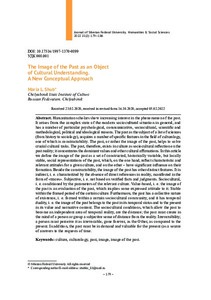Показать сокращенную информацию
The Image of the Past as an Object of Cultural Understanding. A New Conceptual Approach
| Автор | Shub, Maria L. | en |
| Автор | Шуб, М. Л. | ru_RU |
| Дата внесения | 2022-03-10T06:28:46Z | |
| Дата, когда ресурс стал доступен | 2022-03-10T06:28:46Z | |
| Дата публикации | 2022-02 | |
| URI (для ссылок/цитирований) | https://elib.sfu-kras.ru/handle/2311/145353 | |
| Аннотация | Humanitarian scholars show increasing interest in the phenomenon of the past. It arises from the complex state of the modern sociocultural situation in general, and has a number of particular psychological, communicative, sociocultural, scientific and methodological, political and ideological reasons. The past as the subject of a list of sciences (from history to sociology), acquires a number of specific features in the field of culturology, one of which is constructability. The past, or rather the image of the past, helps to solve crucial cultural tasks. The past, therefore, exists in culture as sociocultural reflection on the past reality; it concentrates the dominant values and other cultural affirmations. In this article we define the image of the past as a set of constructed, historically variable, but locally stable, social representations of the past, which, on the one hand, reflect characteristic and relevant attitudes for a given culture, and on the other – have significant influence on their formation. Beside the constructability, the image of the past has other distinct features. It is indirect, i. e. characterized by the absence of direct references in reality, manifested in the form of «traces». Subjective, i. e. not based on verified facts and judgments. Sociocultural, i. e. conditioned by the parameters of the relevant culture. Value-based, i. e. the image of the past is an evaluation of the past, which implies some expressed attitude to it. Stable within the framed period of the certain culture. Furthermore, the past has a collective nature of existence, i. e. formed within a certain sociocultural community, and it has temporal duality, i. e. the image of the past belongs to the past in its temporal status and to the present in its value and normative content. The sociocultural conditions, which allow the past to become an independent area of temporal reality, are the distance; the past must create in the mind of a person or group a subjective sense of distance from the reality. Irreversibility; a person must perceive it as irrevocable, gone forever, as the Other, as compared to the present. In addition, the past must be in demand and valuable for the present (as a source of answers to the requests of time | en |
| Аннотация | Актуализация исследовательского интереса ученых-гуманитариев к феномену прошлого обусловлена комплексным состоянием современной культуры, но может конкретизироваться через ряд наиболее значимых причин психологического, коммуникативного, научно-методологического, политико-идеологического и социокультурного порядка. Являясь предметом интереса целого ряда наук (от истории до социологии), в пространстве культурологии прошлое приобретает ряд специфических черт, главной из которых можно назвать конструируемость. Прошлое, точнее его образ, созидается культурой для решения наиболее значимых для нее в актуальности задач, существуя в ней как результат социокультурной рефлексии относительно минувшей реальности и концентрируя в себе доминантные ценностные и иные установки культуры. Под образом прошлого в контексте данной статьи понимается совокупность конструируемых, исторически изменчивых, но локально устойчивых, социальных представлений о прошлом, которые, с одной стороны, отражают характерные и значимые для данной культуры установки, а с другой – оказывают значительное влияние на их формирование. Наиболее значимыми сущностными параметрами образа прошлого (помимо упомянутой конструируемости) являются: опосредованность (отсутствие прямых референций в реальности, их присутствие в форме «следов»), субъективность (наполненность неверифицированным контентом), социокультурная детерминируемость (обусловленность параметрами актуальной культуры), ценностная окрашенность, коллективная природа бытования, устойчивость в рамках определённого периода существования культуры, темпоральный дуализм (принадлежность к сфере прошлого по своему темпоральному статусу и к сфере настоящего по своему ценностно-нормативному наполнению). Социокультурными условиями формирования образа прошлого выступают дистантность (осмысление прошлого как принципиально Другого по отношению к настоящему), необратимость (восприятие прошлого как тотально невозвращаемого, ушедшего навсегда), востребованность (прошлое должно помогать решать актуально значимые проблемы) | ru_RU |
| Язык | en | en |
| Издатель | Сибирский федеральный университет. Siberian Federal University | en |
| Тема | culture | en |
| Тема | culturology | en |
| Тема | past | en |
| Тема | image | en |
| Тема | image of the past | en |
| Тема | культура | ru_RU |
| Тема | культурология | ru_RU |
| Тема | прошлое | ru_RU |
| Тема | образ | ru_RU |
| Тема | образ прошлого | ru_RU |
| Название | The Image of the Past as an Object of Cultural Understanding. A New Conceptual Approach | en |
| Альтернативное название | Образ прошлого как объект культурологического осмысления: новый концептуальный поворот | ru_RU |
| Тип | Journal Article | en |
| Контакты автора | Shub, Maria L.: Chelyabinsk State Institute of Culture Russian Federation, Chelyabinsk; shubka_83@mail.ru | en |
| Контакты автора | Шуб, М. Л.: Челябинский государственный институт культуры Российская Федерация, Челябинск | ru_RU |
| Страницы | 179–186 | ru_RU |
| DOI | 10.17516/1997-1370-0899 | |
| Журнал | Журнал Сибирского федерального университета. Гуманитарные науки. Journal of Siberian Federal University. Humanities & Social Sciences 2022 15 (2) | en |

